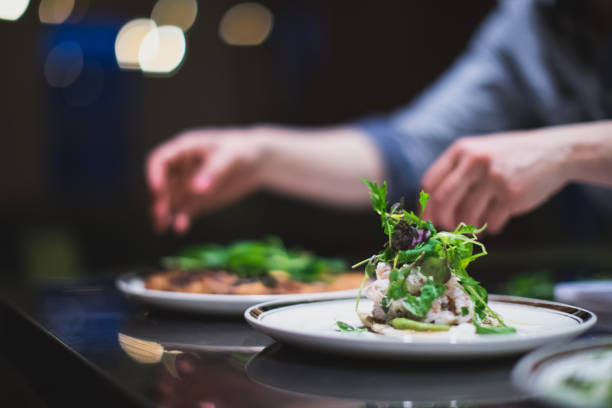Culinary Alchemy: Transforming Humble Ingredients into Gourmet Delights
Discover the art of elevating everyday ingredients into extraordinary dishes. This culinary journey explores innovative techniques and creative pairings that turn simple components into gastronomic masterpieces. From reimagining leftovers to unlocking hidden flavors, learn how to transform your kitchen into a playground of culinary experimentation.

Texture Alchemy: Reimagining Ingredient Forms
One of the most powerful ways to transform humble ingredients is by altering their texture. This technique can completely change how we perceive and enjoy familiar foods. Consider the potato, a staple in many cuisines. When mashed and combined with butter and cream, it becomes a luxurious side dish. But what if we take it further? By dehydrating thin slices of potato and then frying them, we create delicate potato crisps that can be used as a garnish or a base for canapés. Alternatively, grating potatoes finely and forming them into thin sheets before baking creates a crispy, lacy potato galette that’s both visually stunning and texturally complex. This principle can be applied to numerous ingredients. Carrots, for instance, can be spiralized into noodles, offering a low-carb pasta alternative, or blended into a smooth, creamy soup that feels indulgent despite its simple origins. By experimenting with different textures, we can breathe new life into familiar ingredients and create dishes that are both exciting and satisfying.
Flavor Pairing: Unexpected Combinations
The art of flavor pairing is a cornerstone of culinary innovation. By combining ingredients in unexpected ways, we can create dishes that are greater than the sum of their parts. This approach can transform even the most basic ingredients into something truly special. Consider the humble tomato. While delicious on its own, its flavor can be amplified and transformed through thoughtful pairings. For example, combining tomatoes with strawberries might seem unconventional, but the similar flavor compounds in these fruits create a harmonious and intriguing combination. This pairing can be the basis for a unique salsa or a refreshing summer soup. Another unexpected but delightful combination is chocolate and avocado. The creamy texture of avocado complements the richness of chocolate, creating a decadent mousse or a healthier alternative to traditional chocolate desserts. By exploring these unexpected flavor combinations, we can create dishes that surprise and delight the palate, turning simple ingredients into gourmet experiences.
Technique Mastery: Elevating Through Method
The transformation of humble ingredients often lies not in the ingredients themselves, but in the techniques used to prepare them. Mastering various cooking methods can significantly elevate the simplest of foods. Take the onion, for example. When quickly sautéed, it provides a sharp, pungent flavor. However, when slowly caramelized over low heat for an extended period, it transforms into a sweet, complex condiment that can elevate sandwiches, pizzas, or serve as a base for French onion soup. Similarly, the technique of sous vide cooking can transform tough cuts of meat into tender, flavorful delicacies. By cooking at precise low temperatures for long periods, even inexpensive cuts like chuck roast can rival the texture and taste of prime cuts. Fermentation is another technique that can dramatically alter ingredients. Simple cabbage becomes complex sauerkraut, milk transforms into tangy yogurt, and tea leaves develop into kombucha. By focusing on technique, we can unlock hidden potential in everyday ingredients, creating dishes that are both sophisticated and accessible.
Presentation: The Final Touch
The final step in transforming humble ingredients into gourmet delights lies in presentation. How a dish is plated can significantly impact its perception and enjoyment. Even the simplest of meals can be elevated to restaurant-quality with thoughtful presentation. Consider a basic dish of roasted vegetables. When haphazardly piled on a plate, it might look unappetizing. However, when carefully arranged with attention to color contrast, height, and negative space, the same ingredients can become a visually stunning dish. Techniques like quenelling soft ingredients, creating sauce swooshes, or using edible flowers as garnishes can add a touch of elegance to home-cooked meals. Even the choice of dinnerware can make a difference. Serving a rustic stew in a hollowed-out bread bowl or presenting a simple sorbet in a frozen fruit shell can transform the dining experience. By paying attention to these final touches, we can create meals that not only taste extraordinary but look the part as well, truly elevating humble ingredients to gourmet status.
Culinary Transformation Tips
• Experiment with different cooking methods for the same ingredient
• Use herbs and spices to add complexity to simple dishes
• Try unconventional flavor pairings to create unique taste experiences
• Focus on contrasting textures to make dishes more interesting
• Use garnishes and plating techniques to enhance visual appeal
• Don’t overlook the power of slow cooking to develop flavors
• Incorporate fermented ingredients to add depth to dishes
• Use high-quality finishing touches like artisanal oils or flaky sea salt
• Consider the balance of flavors: sweet, salty, sour, bitter, and umami
• Learn classic culinary ratios to create sauces and dressings from scratch
In conclusion, the transformation of humble ingredients into gourmet delights is a testament to the creativity and skill of the cook. By mastering techniques, exploring flavor combinations, and paying attention to presentation, we can elevate even the most basic components into extraordinary culinary experiences. This approach not only results in delicious meals but also fosters a deeper appreciation for ingredients and the culinary arts. As we continue to explore and experiment in our kitchens, we unlock endless possibilities for turning the ordinary into the extraordinary, one dish at a time.





